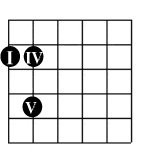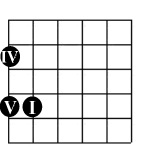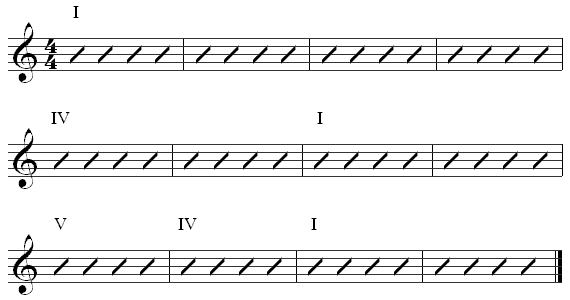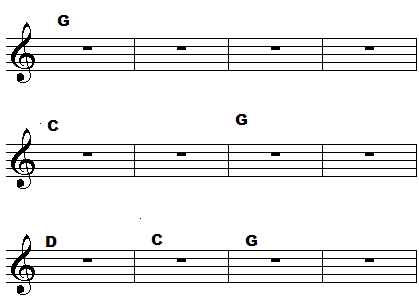Three-chord tunes are the most common in popular music because a melody may dwell on any note of the scale. Often the chords may be selected to fit a pre-conceived melody, but just as often it is the progression itself that gives rise to the melody.
The three-chord I, IV, V, progression, a particularly popular kind of circle progression, can be placed into a four-bar phrase in several ways that have been put to endless use in popular music.
- I – IV – V – V. (The Beatles’s “Lucy in the Sky with Diamonds”)
- I – I – IV – V. (The Rolling Stones’ “Get Off Of My Cloud”)
- I – IV – I – V. (Solomon Linda’s “Mbube”/”Wimoweh”/”The Lion Sleeps Tonight”)
- I – IV – V – IV. (Chip Taylor/The Troggs’ “Wild Thing”)
Armed only with this information, you can pretty much play any blues, rock or traditional song in any key. In this lesson we’ll:
- Learn why we use Roman numerals to notate chord progressions
- Look deeper into progressions that use these “one, four, five” chords such as “Leaving On A Jet Plane”, “Sweet Home Alabama”, and “This Land Is Your Land”.
Roman Numerals
We can use Roman numerals to indicate a chord’s relationship to the key. In this lesson, we’ll talk mostly about the G, C, and D chord in the key of G.
The “I” chord is the first chord in the key, “IV” is the fourth chord in the key, and “V” is the fifth chord in the key. Therefore, in the key of G, our I, IV, V chords are:
- I= G
- IV=C
- V= D
If you want to learn more about the Roman numeral system, please review this lesson. It’s an important lesson, but it’s a lot of information to take in. For the purpose of this lesson you really don’t need to know all the little details because we’re just going to talk about the I, IV, V chords or “one, four, five” chords. They are not a type of chord, but how the chord is related to the key signature.
Diagram 1
The quickest way to find your I, IV, V chords for any key is to use a pattern such as in the following diagram:

The diagram shows us where the IV and V chords would be when the I chord falls on the low E string. On the same fret of the A string is the IV chord and 2 frets higher is the V chord.
The I chord will always be the same as the name. For example, in the key of G the I chord is G. The G chord’s root is a G note and we know that the 3rd fret is a G, so our I chord is on the 3rd fret of the low E string. That would make C the IV chord and D the V chord.
Diagram 2

Almost anything by Woody Guthrie, including “This Land Is Your Land.” Just start out on the I chord and when you hear a chord shift, nine times out of ten it’s either to the IV or V chord.
Here’s an example:
What would “Leaving On A Jet Plane” look like if labeled with Roman numerals?
I IV
So kiss me and smile for me,
I IV
Tell me that you'll wait for me,
I IV V
Hold me like you'll never let me go.
What about “Sweet Home Alabama”? It’s one of those songs with a weird chord progression that begins on the V chord. That may cause some to wrongly accuse the song of being in the key of D, but that’s not so as it is, in fact, the key of G. For further proof you can look at the guitar solos which use the G pentatonic predominantly.
V IV I Sweet home Alabama V IV I Where the skies are so blue V IV I Sweet Home Alabama V IV V Lord, I'm coming home to you
In the song “Red Red Wine”, the lyrics “Red red” at the beginning of the verse is sung over the V chord then onto the “wine” over the I chord. The V chord and it’s lyrics serve as a pickup line going into the verse with full instrumentation (or where you would start a steady sense of time with your strumming).
V I IV V
Red red wine,
I IV V
Go to my head
I IV V
Make me forget that I
I IV V
Still need her soThings start to get cloudy on the song “Can’t You See”.
You may ask, “Can’t You See has the same chords as Sweet Home Alabama, which is in the key of G, so doesn’t that mean it is in the key of G, too?”
The answer is “no”. The song “Can’t You See”, is in fact, the key of D. This might lead to a series of questions…
“How can you tell?”
“How can this be?”
“If two songs have the same chord progression, how can they be in separate keys?”
“Why does my mind hurt?”
The biggest giveaway that the song is in the key of D is that the song’s melody uses the D major scale as do the soloists.
Examples Songs That Use Only 3 Chords
Sweet Home Alabama
Lynyrd Skynyrd was a very talented group that filled their song recordings with a lot of great instrumentation. We’ll look a some of the individual instrumentation which can be played on acoustic, but first let’s learn the core of the song.
http://gty.im/576813924
Verse
The first verse begins with a trip back to “Alabamy”. Surely it was written on a tour bus hence the ‘big wheels’.
D C G
Big wheels keep on turning
D C G
Carry me home to see my kin
D C G
Singing songs about the southland
D C G
I miss Alabamy once again
And I think its a sin, yes
Verse 2
D C G
Well I heard mister Young sing about her
D C G
Well, I heard ole Neil put her down
D C G
Well, I hope Neil Young will remember
D C G
A southern man don't need him around anyhowChorus
D C G Sweet home Alabama D C G Where the skies are so blue D C G Sweet Home Alabama D C G Lord, I'm coming home to you
At the end of the second chorus, a tag is added right before the solos start:
Here I come Alabama
Verse
In Birmingham they love the governor Now we all did what we could do Now Watergate does not bother me Does your conscience bother you? Tell the truth
Verse
This verse talks about the now legendary recording studio Muscle Shoals Sound Studio in Alabama where Lynyrd Skynryd recorded some of their albums.
The ‘Swappers’ is the name of the four session musicians that founded the studio who “have been known to pick a song or two”.
Now Muscle Shoals has got the Swappers And they've been known to pick a song or two Lord they get me off so much They pick me up when I'm feeling blue Now how about you?
Outro
Sweet home Alabama Oh sweet home baby Where the skies are so blue And the governor's true Sweet Home Alabama Lordy Lord, I'm coming home to you
Can’t You See
Verse 1
The verse lasts for 8 measures. You can divide the verse into two halves. The first part half deals with taking a freight train and goes like this:
D
I'm gonna take a freight train,
C
Down at the station
G
I don't care
D
where it goes
The second half of the first verse were climbing a mountain to jump off. Pretty depressing stuff!
D
Gonna climb me a mountain,
C
The highest mountain, Lord,
G
Gonna jump off
D
nobody gonna know
Chorus
When the song gets to the chorus we understand why all the dramatic lyrics in the verse.
D C G D
Can't you see, can't you see, what that woman, she been doin' to me
D C G D
Can't you see, can't you see, what that woman been doin' to meThe lyric “can’t you see” is sung over the D chord and then the C chord. “what that woman” is over the G chord, and “she been doin’ to me” is over the D.
Verse 2
D
I'm gonna find me
C
A hole in the wall
G D
gona crawl inside and die
D C
That lady, mean ol' woman Lord
G D
Never told me goodbyeVerse 3
D
Gonna buy me a ticket now,
C
As far as I can,
G D
Ain't never comin' back
D
Take me Southbound,
C
All the way to Georgia now,
G D
Till the train run out of track12 Bar Blues
The 12-bar blues is one of the most popular chord progressions in popular music, including the blues. The blues progression has a distinctive form in chord structure and duration. It is, at its most basic, based on the I-IV-V chords of a key.
The 12 bar blues progression is the foundation of the blues.
There are two common variations of the 12 bar blues progression.

- I=G
- IV=C
- V=D

Variation:

